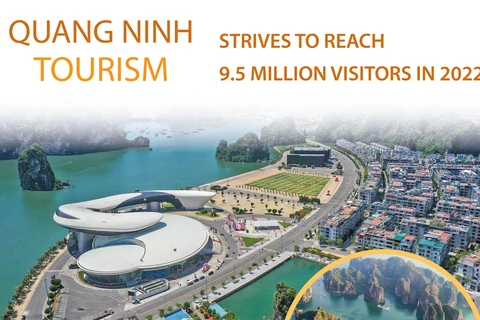Quang Ninh (VNA) – The tourism sector in the northern coastal province of Quang Ninh, home to the iconic UNESCO-recognised World Heritage Site Ha Long Bay, is launching a series of measures to operate in a new normal condition, ensuring safety for visitors, according to local authorities.
The move is in response to the Government’s approval of reopening tourism activities in such condition starting from March 15 after a two-year hiatus because of the COVID-19.
Right from the beginning of 2022, Quang Ninh opened a number of tourist attractions that meet the requirements and are labeled as safe, especially spiritual sites, attracting hundreds of thousands of visitors.
At accommodation service establishments in Quang Ninh, room occupancy has begun to increase again. Currently, the province has nearly 700 tourism businesses meeting the provincial safety criteria for epidemic prevention and control.
Pham Ngoc Thuy, Director of the provincial Department of Tourism, said Quang Ninh has launched activities to welcome tourists from the beginning of the year in adaptation to the new situation. The works have so far produced effective and safe outcomes, he added.
Quang Ninh is targeting 9.5 million visitors in 2022./.
The move is in response to the Government’s approval of reopening tourism activities in such condition starting from March 15 after a two-year hiatus because of the COVID-19.
Right from the beginning of 2022, Quang Ninh opened a number of tourist attractions that meet the requirements and are labeled as safe, especially spiritual sites, attracting hundreds of thousands of visitors.
At accommodation service establishments in Quang Ninh, room occupancy has begun to increase again. Currently, the province has nearly 700 tourism businesses meeting the provincial safety criteria for epidemic prevention and control.
Pham Ngoc Thuy, Director of the provincial Department of Tourism, said Quang Ninh has launched activities to welcome tourists from the beginning of the year in adaptation to the new situation. The works have so far produced effective and safe outcomes, he added.
Quang Ninh is targeting 9.5 million visitors in 2022./.
| The northern coastal province of Quang Ninh is determined to quickly and sustainably recover the local tourism this year by welcoming between 9.53 million to 10 million visitors, including 1.5 million foreigners, said Vice Chairwoman of the provincial People’s Committee Nguyen Thi Hanh. According to Hanh, the province boasts the highest rate of people getting third COVID-19 vaccine shots in Vietnam as well as a safe, flexible, and effective adaptation to the pandemic. Via communications campaigns, the development of new products, including night-time economic activities, and the organisation of large-scale tourism, sport, and cultural events, the province’s tourism recovery programme this year targets a full restoration of all activities and products; and safety for tourists. Hanh informed that in February and March, the local authorities will work with big travel companies and competent agencies of such key tourist markets as Hanoi and Ho Chi Minh City. Quang Ninh welcomed over 300,000 holidaymakers in the six-day Lunar New Year (Tet) holiday from January 31 to February 5, earning around 400 billion VND (17.6 million USD). Local religious establishments such as Yen Tu relic site, Ba Vang, Ngoa Van and Cai Bau pagodas, and Cua Ong temple, together with Ha Long Bay – a UNESCO-recognised World Heritage Site, were the most attractive to tourists during the period. From January 1 to June 30, Quang Ninh offers a 50-percent discount of tickets to many destinations like the Yen Tu scenic site, Ha Long Bay, and the province’s museum and library. Quang Ninh is endowed with natural advantages for sea and island tourism. It has a coastline of more than 250 kilometres and more than 2,000 islands and islets which account for two-thirds of the total number in Vietnam. It is home to popular destinations such as Ha Long Bay, Bai Tu Long, Ha Long Bay National Park and some islands. In particular, Ha Long Bay literally “descending dragon” bay, was twice recognised as a World Natural Heritage site by UNESCO in 1994 and 2000. The bay spans 1,553 square kilometres and includes 1,969 islands of various sizes. It features thousands of limestone karsts and islets in various shapes and sizes. The limestone in the bay has gone through 500 million years of formation in different conditions and environments. The geo-diversity of the environment has created biodiversity, including a tropical evergreen biosystem, oceanic and sea biosystem./. |
VNA

























